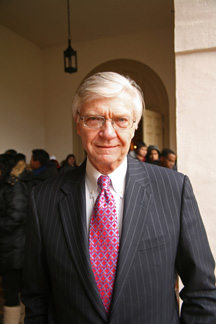From the Brafferton
This column by President Taylor Reveley originally ran in the summer 2009 issue of the William & Mary Alumni Magazine. -Ed
 Three historic buildings emerged from William and Mary's first building boom. It began in 1695, when ground was broken for the Wren Building, and continued until 1733. By then the Brafferton and the President's House, as well as the chapel wing of the Wren, had come on line. Collectively, they make up our storied "colonial" or "ancient" campus. These are the oldest buildings in the United States where college classes are still held and shelter is still provided to college presidents.
Three historic buildings emerged from William and Mary's first building boom. It began in 1695, when ground was broken for the Wren Building, and continued until 1733. By then the Brafferton and the President's House, as well as the chapel wing of the Wren, had come on line. Collectively, they make up our storied "colonial" or "ancient" campus. These are the oldest buildings in the United States where college classes are still held and shelter is still provided to college presidents.
William and Mary waited almost two centuries for its second building boom. It occurred in the exuberant 1920s and the depressed 1930s (sound familiar?), producing the "colonial revival" or "Sunken Garden" campus. Between 1920 and 1935, the College built most of the residence halls and classroom buildings that line the Sunken Garden, as well as a stadium, gymnasium, infirmary and Sorority Court - almost 20 facilities in total.
The late 1950s saw the third wave of massive construction at William and Mary. First came the Bryan Complex and Phi Beta Kappa Memorial Hall. Then, throughout the 1960s, building followed building to create what became known as "new campus." Perhaps "new" has outlived its time, however. Because the buildings of the third boom are now pretty long in the tooth - indeed, often yellow and cracked in the tooth - a new name might make sense, maybe "west" or "south" campus.
Since the turn of the 21st century, the university has been caught in the rejuvenating embrace of its fourth, and perhaps its greatest, building boom. This one entails constructing or totally renovating 21 buildings on the main campus and five more at VIMS and involves 1.5 million square feet. The law school got the ball rolling with a new wing for its facility on South Henry Street. With the new wing came vitally needed classrooms, offices and meeting spaces. We now have a splendid new recreation center on the main campus, frequented day and night by seekers after fitness, and an elegant new center for undergraduate admissions in the old College bookstore, totally rebuilt. The Commons Dining Hall - "the Caf" - has received a long-awaited upgrade. The Laycock Center provides an extraordinary new home for Tribe football, while the Jamestown dormitories grace the southern edge of campus, bringing the College closer (though not close enough) to meeting the huge demand for on-campus housing.
Both Swem Library on the main campus and the Wolf Law Library have been wonderfully transformed by renovation and the construction of additions, which fit seamlessly into the whole. At VIMS, Andrews Hall and the Seawater Research Laboratory, the largest in the United States, have greatly expanded classroom, lab and office space for our marine scientists.
Small Hall, home of our physics department, has added an ultra high field, solid state magnet laboratory and is now undergoing an expansion and significant renovation. The first phase of the Integrated Science Center (ISC), a desperately needed facility built between Rogers and Millington halls, opened last summer, and the ISC's second phase, a renovated Rogers, got in gear this spring. Plans are underway for the third and final phase of the ISC. It will hinge on $85 million in state funding. We are hopeful.
A spectacular new home for the Mason School of Business - Miller Hall - approaches completion on the shore of Lake Matoaka, near the splendidly renovated Amphitheater. A vast new facility for the School of Education is taking shape on Monticello Avenue. Next fall, we will begin construction for the Sherman and Gloria H. Cohen Career Center for counseling students about jobs and helping in their pursuit. The Cohen Center will sit between Zable Stadium and the Sadler Center.
This does not describe everything entailed in William and Mary's fourth building boom, but the magnitude of the effort is clear. Once the business and education schools leave their current quarters on the main campus, new space will open up for arts and sciences departments. Parts of the university still live and work in inadequate facilities. Much remains to be done. But physically speaking, the fourth building boom is moving William and Mary powerfully into the 21st century.
People are the mortar holding a great university together, however, not steel and concrete. Students, faculty and staff of compelling character and talent have been William and Mary's glory in good times and bad, when our facilities were cutting-edge and when they creaked and leaked. All the bricks in the world would avail us naught if our people lacked integrity, ability and ambition. But when extraordinary people are coupled with extraordinary buildings, then William and Mary's juggernaut really begins to roll!
W. Taylor Reveley III
President, College of William and Mary














